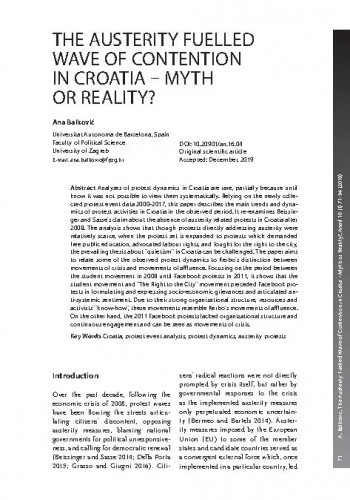Analyses of protest dynamics in Croatia are rare, partially because until know it was not possible to view them systematically. Relying on the newly collected protest event data 2000-2017, this paper describes the main trends and dynamics of protest activities in Croatia in the observed period. It re-examines Beissinger and Sasse's claim about the absence of austerity related protests in Croatia after 2008. The analysis shows that though protests directly addressing austerity were relatively scarce, when the protest set is expanded to protests which demanded free public education, advocated labour rights, and fought for the right to the city, the prevailing thesis about "quietism" in Croatia can be challenged. The paper aims to relate some of the observed protest dynamics to Kerbo's distinction between movements of crisis and movements of affluence. Focusing on the period between the student movement in 2008 until Facebook protests in 2011, it shows that the student movement and "the right to the city" movement preceded Facebook pro- tests in formulating and expressing socio-economic grievances and articulated anti-systemic sentiment. Due to their strong organizational structure, resources and activists' "know-how", these movements resemble Kerbo's movements of affluence. On the other hand, the 2011 Facebook protests lacked organizational structure and continuous engagement and can be seen as movements of crisis.; Rijetke su analize prosvjedne dinamike u Hrvatskoj, djelomice zato što se dosad nije mogla analizirati sustavno. Oslanjajući se na nove podatke o prosvjednim događajima od 2000. do 2017, ovaj rad opisuje glavne trendove i dinamiku prosvjednih aktivnosti u Hrvatskoj u tom razdoblju. Rad preispituje tezu Beissingera i Sasse o nepostojanju prosvjeda protiv politike štednje u Hrvatskoj nakon 2008. Unatoč tome što su prosvjedi koji su se izravno ticali politike štednje bili relativno rijetki, ako se uzorak prosvjednih događaja proširi na prosvjede koji su zahtijevali besplatno javno školstvo, zagovarali prava radnika i borili se za pravo na grad, onda je upitan stav o "tišini" u Hrvatskoj. Ovaj rad kani povezati dio prosvjedne dinamike s Kerbovom razlikom između pokretâ u vremenima krize i obilja. Usredotočujući se na razdoblje od studenskih prosvjeda 2008. do Facebook-prosvjeda 2011, rad pokazuje da su studentski pokret i pokret "Pravo na grad" prethodili Facebook-prosvjedima u formuliranju i izražavanju socijalno-ekonomskih zahtjeva te artikuliranju antisistemskih osjećaja. zahvaljujući snažnoj organizacijskoj strukturi i resursima aktivista, ti su pokreti nalikovali na Kerbove pokrete u vrijeme obilja. Istodobno, Facebook-prosvjedima nedostajali su organizacijska struktura i kontinuirano sudjelovanje građana te odgovaraju pokretima u doba krize.
Sažetak

 Anali Hrvatskog politološkog društva : časopis Hrvatskog politološkog društva : 16,1(2019) / glavna i odgovorna urednica Mirjana Kasapović.
Anali Hrvatskog politološkog društva : časopis Hrvatskog politološkog društva : 16,1(2019) / glavna i odgovorna urednica Mirjana Kasapović.